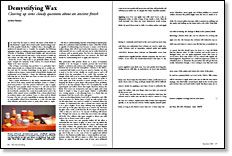Demystifying Wax
Clearing up some cloudy questions about an ancient finish
Synopsis: Wax is a misunderstood material. Bob Flexner finds many manufacturers’ claims to be nonsense, and in this article he sets about clearing up myths. He explains how wax is made and discusses its properties, how to protect it, and how to apply it, as well as how to revive it. Detailed side information relays his tests on floor wax, paste wax, and liquid wax and how they compare.
I’ve used wax for years to restore the luster of the finish on the furniture I repair. But it wasn’t until I started testing some of the popular brands that I realized what a thoroughly misunderstood material wax is. Consider, for example, the following statements made by well-known polish manufacturers and authors of books on finishing: “A finish must breathe, and wax prevents this.” “You should remove wax twice a year because it builds up and softens the film with age.” “This traditional polishing wax …feeds the wood.” “Wax tends to get gradually darker over the years.” Despite the authority of the sources, I’ve found all these claims to be utter nonsense.
The ad hype concerning wax products is so prevalent that I think many people are confused about using wax to polish, protect and care for wooden furnishings. In my quest to clear up confusion about waxes, I interviewed a dozen finish chemists and professional wood finishers. I hope the following explanations will clear the air about what wax does (or does not do), how it works and how to use it.
First, a quick introduction to the waxes. Manufacturers today can choose from many natural and synthetic waxes to obtain a good wax product—one that protects well and is easy to apply. Among the most popular waxes: Beeswax is a soft wax secreted by bees for comb building and was historically the primary wax for woodwork; carnauba wax comes from palm leaves and is the hardest of the natural waxes; candelilla, from a desert plant found in northern Mexico and southern Texas, is often used in blends because of its low cost and compatibility in mixing with other waxes; and paraffin refined from petroleum is a very soft wax that’s often blended with harder waxes to make them easier to apply. Dozens of brands of commercial waxes suitable for applying over furniture finishes are available. Among the most common raw ingredients are the ones shown in the plastic bags at the right. From left to right: beeswax, candelilla and carnauba.
The key to understanding wax lies in knowing its natural properties: It’s a substance that’s insoluble in water; a thin film of wax is capable of withstanding wear because it creates a low-friction surface things slide off of; wax bonds with tenacity to almost any solid material, but not to itself; and wax can be easily dissolved in a solvent, such as mineral spirits. The first two characteristics are important for understanding how wax protects, the third and fourth for understanding how to apply and remove it.
From Fine Woodworking #70
For the full article, download the PDF below:
Fine Woodworking Recommended Products

Compass

Bahco 6-Inch Card Scraper

Double Sided Tape






















Comments
Great article but the second page of the .pdf document is incomplete. Lucky for me I found an old (1988) FWW issue to fill in the blanks.
I couldn't understand a lot from the second page... its wrong.
Log in or create an account to post a comment.
Sign up Log in